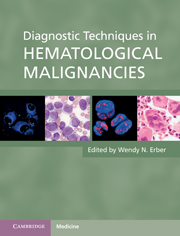Book contents
- Frontmatter
- Contents
- List of Contributors
- Preface
- Part 1 Diagnostic techniques
- Part 2 Hematological malignancies
- 6 The integrated approach to the diagnosis of hematological malignancies
- 7 Acute lymphoblastic leukemia
- 8 Acute myeloid leukemia
- 9 Mature B-cell leukemias
- 10 Mature T-cell and natural-killer cell leukemias
- 11 Lymphoma
- 12 Plasma cell neoplasms
- 13 Chronic myeloid leukemia
- 14 Myeloproliferative neoplasms
- 15 Myelodysplastic syndromes and myelodysplastic/myeloproliferative neoplasms
- Index
- References
8 - Acute myeloid leukemia
from Part 2 - Hematological malignancies
Published online by Cambridge University Press: 06 December 2010
- Frontmatter
- Contents
- List of Contributors
- Preface
- Part 1 Diagnostic techniques
- Part 2 Hematological malignancies
- 6 The integrated approach to the diagnosis of hematological malignancies
- 7 Acute lymphoblastic leukemia
- 8 Acute myeloid leukemia
- 9 Mature B-cell leukemias
- 10 Mature T-cell and natural-killer cell leukemias
- 11 Lymphoma
- 12 Plasma cell neoplasms
- 13 Chronic myeloid leukemia
- 14 Myeloproliferative neoplasms
- 15 Myelodysplastic syndromes and myelodysplastic/myeloproliferative neoplasms
- Index
- References
Summary
Introduction
Acute myeloid leukemia (AML) encompasses a highly heterogeneous group of clonal disorders arising in hematopoietic progenitors that are characterized by a block in differentiation and outgrowth of myeloid blasts giving rise to bone marrow failure. Although AML is not particularly common, affecting approximately 3 individuals per 100 000 population per year in Western countries (i.e. ~2000 new cases per year in the UK), it is challenging and expensive to treat, representing a significant burden on healthcare systems. Given that AML is predominantly a disease of the elderly, with markedly higher incidence in individuals over 60 years of age, this disease is set to become an increasing problem as the population ages.
Molecular basis of AML
The last three decades have witnessed major advances in deciphering the cytogenetic and molecular lesions underlying the pathogenesis of AML. These have not only afforded significant insights into disease biology, but also proved helpful in providing prognostic information and underpinned the development of molecularly targeted and risk-stratified treatment approaches. A further benefit of improved understanding of the molecular basis of AML coupled with the development of sensitive quantitative polymerase chain techniques has been the possibility to assess treatment response at the submicroscopic level (i.e. detection of minimal residual disease, MRD), thereby affording the opportunity to tailor therapy more precisely to the needs of the individual patient.
- Type
- Chapter
- Information
- Diagnostic Techniques in Hematological Malignancies , pp. 146 - 170Publisher: Cambridge University PressPrint publication year: 2010

